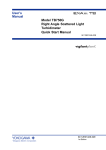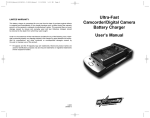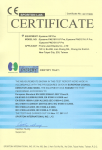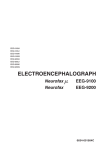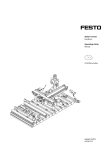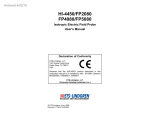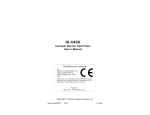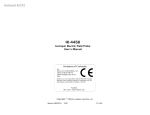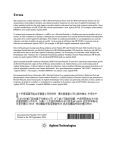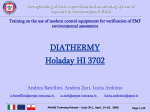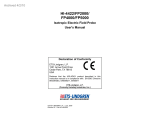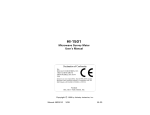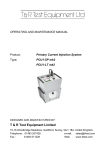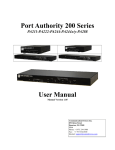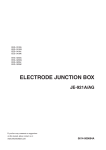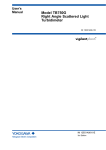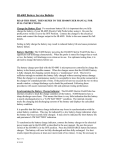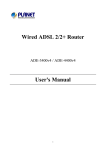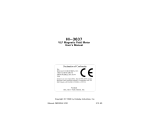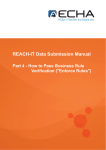Download HI-3701 - ETS
Transcript
HI-3701 Induced Current Meter User's Manual Copyright © 1996 Holaday Ind. Inc. Manual #600048 03/96 $12.50 Revision Record Manual # 600048 HI-3701 Induced Current Meter Revision --A B C Description Preliminary Release Release Battery charger change Updated sensor Date 9/92 4/93 12/94 3/96 TABLE OF CONTENTS Section 1 -- Product Overview . . . . . . . . . . . . . . 1 Introduction . . . . . . . . . . . . . . . . . . . . . . . 1 Specifications . . . . . . . . . . . . . . . . . . . . . . 3 Section 2 -- Operating the HI-3701 . . . . . . Introduction . . . . . . . . . . . . . . . . . Unpacking and Acceptance . . . . . . . Getting Started . . . . . . . . . . . . . . . Controls, Indicators, and Connectors . . . . . . . . . . . . . . . . . . . . . . . . . Section 3 -- Making Measurements . . . . . . Introduction . . . . . . . . . . . . . . . . . Generic Measurement Considerations Measurement Technique . . . . . . . . . Heat Sealer Application Example . . . Antenna Farm Application Example . . . . . . . . . . . . . . . . . . . . . . . . . . 11 . 11 . 11 13 . 14 . 14 . . . . . . . . . . . . . . . . . . . . . . . . . . . . . . . . . . . . . . . . . . . . . Section 4 -- Maintaining the HI-3701 Introduction . . . . . . . . . . . . Calibration . . . . . . . . . . . . . Cleaning . . . . . . . . . . . . . . . Batteries . . . . . . . . . . . . . . . Battery Charging . . . . . Battery Replacement . . Replacement Parts . . . . . . . . Options . . . . . . . . . . . . . . . . . . . . . . . . . . . . . . . . . . . . . . . . . . . . . . . . . . . . . . . . . . . . . . . . . 5 5 5 6 8 15 15 16 16 16 16 18 20 20 Section 5 -- Principles of Operation . . . . . . . . . . . 21 Introduction . . . . . . . . . . . . . . . . . . . . . . 21 Meter Theory . . . . . . . . . . . . . . . . . . . . . 21 Section 6 -- Remote Readouts and Data Logging Introduction . . . . . . . . . . . . . . . . . . . . HI-3715 Remote Readout . . . . . . . . . . . HI-3715 Indicators . . . . . . . . . . . . . . . . Data Logging . . . . . . . . . . . . . . . . . . . HI-3701 Data Format . . . . . . . . . . . . . . . . . . . . . . . . . 23 23 23 25 26 27 Appendix A -- HI-3701 Calibration Methods . . . . . 29 LIMITED WARRANTY Holaday Industries, Inc. warrants each Model HI-3701 Induced Current Meter to be free from defects in material and workmanship for a period of one year from date of shipment to the purchaser. This warranty extends to the original purchaser only and does not apply to batteries or any product or parts subject to misuse, neglect, accident, unauthorized service or abnormal conditions of operation. In the event of instrument failure covered by this warranty, Holaday Industries, Inc. will, without charge, repair and recalibrate the instrument if returned to their factory within one year of the original purchase, provided that Holaday Industries' examination discloses to its satisfaction that the product was defective. Holaday Industries, Inc may, at its option, replace the product in lieu of repair. If the defect was caused by misuse, neglect, accident, unauthorized service or abnormal conditions of operations, repairs will be billed at a nominal cost. In such case, an estimate will be provided before work is started if requested by the purchaser. For warranty service, contact Holaday Industries, Inc., giving full details of the failure and the serial number of the instrument. You will then be given service information or shipping instructions. Return the instrument to the factory, transportation prepaid. Repairs will be made at the factory and the instrument returned to you, transportation paid. Holaday Industries, Inc. assumes no responsibility for loss of, or damage to, products in transit. !! WARNING !! Special caution is advised when working in environments where contact with high voltage or high current circuits or apparatus is possible. This is particularly true when attempting to obtain induced body current measurements near electrically-powered equipment, such as heat sealers, or in areas marked with warnings about the presence of high voltages, currents, or RF fields. Accidental contact with objects, circuits, or fields operated at high voltages or high current can be lethal! Holaday Industries, Inc. assumes no liability for damages or personal injury which may result from accidents arising out of the use of this equipment. HI-3701 Manual 1.0 Page 1 Product Overview Introduction The HI-3701 Induced Current Meter measures the induced body current of individuals working in environments where radio frequency (RF) electromagnetic fields are present. The Institute of Electrical and Electronics Engineers (IEEE) specification C95.1-1991, IEEE Standard for Safety Levels with Respect to Human Exposure to Radio Frequency Electromagnetic Fields, 3 kHz to 300 GHz, defines the acceptable levels of RFinduced body current for the frequency range of 3 kHz to 100 MHz. The acceptable levels range from 3 mA for uncontrolled exposures at 3 kHz to 200 mA for controlled exposures between 100 kHz and 100 MHz. The HI-3701 is designed to meet the requirements of C95.1-1991. The accuracy of this instrument provides a means for determining compliance. The unit is completely portable and self-contained. Simple to set up and easy to operate, the HI-3701's rugged design can be used for measurements in applications environments such as: ! Induction heating facilities ! Industrial welding applications ! Broadcast transmitting and antenna locations The Model HI-3701 includes as standard the following items: ! Model HI-3701 Meter ! Battery Charger (15 hr. charge cycle) ! User's Manual ! Soft-sided Carrying Case Page 2 HI-3701 Manual Figure 1 HI-3701 Induced Current Meter Optional accessories for the unit include: ! HI-3715 Fiber Optic Remote Readout Unit (includes fiber optic cable) ! Data Logging Computer Interface # Fiber Optic Cable (glass, 4 m length) # HI-4413P Fiber Optic to RS-232 Interface # RS-232C Cable Assembly # Data Logging Software (PC compatible) ! HI-3102 1-Hour Battery Charger HI-3701 Manual Page 3 Specifications Ranges: 10, 30, 100, 300, 1000 mA full scale Frequency Response: 3 kHz to 100 MHz ± 1.0 dB (3 kHz to 30 MHz) ± 2.0 dB (30 MHz to 100 MHz) (See Figure 2) Battery: NiCad Rechargeable 7.2V / 1,300 mA-hrs Battery Charger: 15 Hour charge cycle time Battery Life: Dimensions: Approx. 12 hrs. of operation/charge 360 x 485 x 50mm (14 x 19 x 2 in.) Weight: 6.2 kg (14 lb.) Page 4 HI-3701 Manual Figure 2 Typical Frequency Response HI-3701 Manual Page 5 2.0 Operating the HI-3701 Introduction The operation of the HI-3701 consists of three main steps: 1. 2. 3. Verifying battery condition Turning the unit on and setting the desired range Making the necessary measurements These steps are described in detail in the "Getting Started" procedure provided below. This section also contains descriptions of the HI-3701's switches, controls and indicators. If you are using optional equipment such as the HI-3715 Remote Readout or a remote data logger, information on using those options is found in Section 6, Remote Readout and Data Logging. Measurement considerations and examples are provided in Section 3, Making Measurements. Unpacking and Acceptance Step 1. Remove the meter from its shipping container. Save the boxes and any protective packing materials for future use. Inspect the HI-3701 for concealed damage incurred in transit. If any damage is found, file a claim with the carrier. Step 2. Verify that the materials you received are the same as you ordered and correspond with the packing list. If you find discrepancies, note them and call Holaday Customer Service for further directions. Page 6 HI-3701 Manual Getting Started To get started using the HI-3701 perform the following procedure: Step 1. Set the rotary Function switch (Figure 3) to BAT and verify that the meter reads in the green BAT. OK area. (If the meter reads to the left of the green area, the batteries require recharging. See Section 4, Maintaining the HI-3701). Then set the Function switch to OFF. Step 2. With an acceptable battery indication in Step 1, place the unit in the desired location for the reading. (If you are using any fiber optic accessories connect those units into their fiber optic connector). Figure 3 HI-3701 Component Locations Step 3. Have the subject stand or sit (as appropriate) on the unit metal plate, and set the Function switch to ON. Step 4. Set the rotary Range switch to the range that gives a meter indication from approximately midscale to full scale. HI-3701 Manual Page 7 Step 5. Read the value from the meter. If the selected range is 30 or 300 use the values along the top of the scale. If the selected range is 10, 100, or 1000, use the values along the bottom of the scale. Example (Figure 4): The selected range is 100. The meter indication (bottom scale) is .8. The induced body current measurement is 80 mA. Figure 4 Meter Reading Example 1 Example (Figure 5): The selected range is 30. The meter indication (from the top of the scale) is 2.5. The induced body current measurement is 25 mA. Figure 5 Meter Reading Example 2 Step 6. To improve the accuracy of the measurement for a given individual in a specific location, perform multiple readings and average the results. Section 3, Making Measurements, contains additional information on the set up and Page 8 HI-3701 Manual repetition of measurements. Step 7. When the measurements are complete, set the Function switch to OFF and disconnect any accessories. Controls, Indicators, and Connectors The HI-3701 has the following controls, indicators, and connectors: Function Switch A three-position rotary switch that selects the operational function for the HI-3701. OFF Removes power from the unit. The function switch must be in this position for the battery charger to charge the battery. BAT Used for testing the battery. With the switch in this position, the meter indicates above the green BAT.OK line if the meter is usable. Any other indication means that the battery requires recharging. ON Normal operating position. Switch must be in this position for performing measurements. HI-3701 Manual Range Switch Page 9 A five-position rotary switch that selects the value range for the induced current being measured. 10 Indicates a reading in the range of 10 mA or less. Use the bottom scale on the meter to determine the exact value. 30 Indicates a reading in the range of 30 mA or less. Use the top scale to determine the exact value. 100 Indicates a reading in the range of 100 mA or less. Use the bottom scale on the meter to determine the exact value. 300 Indicates a reading in the range of 300 mA or less. Use the top scale on the meter to determine the exact value. 1000 Indicates a reading in the range of 1000 mA or less. Use the bottom scale on the meter to determine the exact value. Current Meter Charge Jack A dual-scale meter that indicates induced body current in five ranges from 10 mA to 1000 mA. The meter also indicates battery condition with the Function switch in the BAT position. The charger jack is used for connecting the battery charger to the HI-3701. To charge the battery, ensure that the Function switch is in the OFF position and insert the charger plug (Figure 6) into the jack. In any other switch position, the battery will not charge. Page 10 HI-3701 Manual Figure 6 Charger Plug F.O. Jack This jack receives the plug on the fiber optic cable that connects the fiber optic accessories to the HI-3701 (Figure 7). See Section 6, Remote Readout and Data Logging for more information. Figure 7 Fiber Optic Connection HI-3701 Manual 3.0 Page 11 Making Measurements Introduction Successful measurements using the HI-3701 depend on a well-planned measurement series as well as proper operation of the HI–3701. For the HI-3701 data to be meaningful, especially within the definitions of IEEE C95.1-1991, several measurement considerations should be examined before beginning any series of measurements. The factors include: ! Type and intensity of RF-generating device ! Location of personnel throughout the work cycle ! Environmental characteristics ! Surveyor's effects on the RF field In addition, the unique qualities of each measurement site will require additional examination before conducting a measurement series. Providing specific details for making measurements for every kind of application in which the HI-3701 may be used is beyond the scope of this manual. Every individual installation or work site will have specific features that must be accounted for to get the most useful data possible. Generic Measurement Considerations Before making a measurement with the HI-3701, study the area to be measured with the following considerations in mind: Type of RF Device The type of RF-generating device may affect both the location and the number of measurements made. A relatively constant RF field in an antenna farm will require a different series of measurements than those taken in a heat seal work cell. With the heat sealer, the intensity of the RF field and its distribution may vary with how the device operates in the work cycle, the presence of conductors, and other factors. With an awareness of how and when the RF field is being generated, you can take measurements at the right time and in the right place to give a complete picture of personnel Page 12 HI-3701 Manual exposures. Location of Workers Before starting to take measurements, watch the person or persons to be measured go through an entire work cycle. Note the following things: ! Are they standing or sitting? ! How close are they to the RF source? ! Do they move about during the course of a work cycle The answers to these questions may suggest, for example, taking readings at locations within the work space in addition to the chair or place where the person works most of the time. Environmental Characteristics Environmental characteristics include such things as the composition of the floor (wood, concrete, concrete with metal rebar) or the presence of conductive materials (metal storage shelves or structural members). These characteristics may suggest taking additional measurements at a wider range of locations within the work space. Personnel and Apparel Even in the same location and environment, individuals of different body size may provide different induced current measurements. Likewise, the type of shoes, clothing, and (in some cases) accessories such as rings and jewelry can influence measurements. These considerations may suggest taking measurements of personnel during all shifts to get a complete range of readings. Surveyor's Effects If the person using the HI-3701 stands near the person being measured, the measurement can be affected. To minimize these effects have the person being measured call out the reading or use an HI–3715 Remote Readout. HI-3701 Manual Page 13 Measurement Technique To get the most reliable measurement data possible, take at least three measurements at each physical location and work cycle time point. Average the measurements to arrive at a final measurement. The sample table provided below shows how you might create a form to support such a measurement technique. Worker Location/ Cycle Time Read. #1 Read. #2 Read. #3 Average For other measurement techniques see Section 6, Remote Readout and Data Logging. Page 14 HI-3701 Manual Heat Sealer Application Example A floor plan for a heat sealing work station may contain several chairs on which the workers sit. It may also have metal stacking trays for placing finished goods. The fact that the workers will be both sitting and standing during their work cycle suggests the need for standing measurements near the heat sealing units as well as near the conductive metal stacking trays. It also suggests that workers may be exposed to RF when others are using the sealer. That means taking measurements throughout a complete work cycle, whether the individual being measured is using (or near) the heat sealer or not. Antenna Farm Application Example Maintenance and other personnel working in the vicinity of antenna farms, such as those for radio and television transmitters, also experience RF induced body current. Here, specific factors affecting the measurements include the frequency and power of the transmitter, the characteristics (including grounding) of the antenna system, and the location of the personnel -- in the transmitter or station area, on the grounds, or up in the tower. For outside measurements, dampness or dryness may have an impact, so measurements after a rain as well as during a dry period may be called for. When making measurements in this environment, exercise caution about measuring near the antenna or marked danger areas while the transmitter is operating at full power (see Warning on Warranty Page). Record the transmitter output power when any measurement is taken. HI-3701 Manual 4.0 Page 15 Maintaining the HI-3701 Introduction Maintaining the HI-3701 requires that the Nicad batteries be properly charged and that the battery condition be monitored. Under normal operating conditions, recharging the rechargeable battery is the only recommended user-performed maintenance. The normal operational life (approximately 1,000 charge/discharge cycles) of the battery is such that by the time the batteries need replacement, the HI-3701 will probably also need recalibration. These tasks are performed by the Holaday Service Department. In cases of accidental damage to the battery that causes premature failure, it is possible to replace the pack in the field. A procedure and replacement battery part number are provided in this section. Calibration and all other maintenance tasks should be performed by Holaday Industries, Inc. service personnel. Contact the Holaday Service Department to receive return authorization and shipping instructions if you need to return your unit to the factory for maintenance work. CAUTION Except for replacement of a prematurely failed battery, there is no reason for users to open the HI-3701. Be aware that removing the unit back panel may invalidate your warranty. Page 16 HI-3701 Manual Calibration Holaday Industries recommends yearly calibration of the HI-3701 by the Holaday Service Department. At that time, the battery condition is also checked. Cleaning The HI-3701 is water-resistant, but not waterproof. Therefore, clean the unit using a mild detergent and a damp sponge. Do not use high pressure sprays, and under no circumstances should the unit ever be immersed in water or other liquids. Such actions will invalidate the warranty. Batteries The HI-3701 uses a rechargeable battery, rated at 7.2 Vdc / 1,300 mA-hrs. as its power source. A battery charger is provided with the unit. The charger provided requires 15 hours to fully charge the battery. An optional quick charger is available that provides a full charge in approximately 1 hour. Under normal operation, a fully charged battery should provide 12 hours of operation. If the battery fails to hold a charge, or if a significant degradation in operational time occurs, the battery may need replacement. Battery Charging To charge the low battery, perform the following procedure (Figure 7): Step 1. Set the Function switch to OFF. The battery will only charge with the switch in this position. Step 2. Plug the charger into an AC outlet. Step 3. Plug the charger jack all the way into the CHARGE plug (Figure 8). HI-3701 Manual Page 17 Figure 8 Plug and Switch Settings for Recharging Step 4. Verify that the green light on the charger unit is lit, indicating that the unit is charging. Allow 15 hours for a full charge cycle. Note Charging the battery up to approximately 24 hours will not harm the battery pack. However, charging the pack longer than 24 hours could degrade battery performance. Step 5. At the completion of the charge cycle, remove the charger plug from the CHARGE jack and unplug the charger from the AC outlet. Set the Function Switch to BAT and verify that the meter reads above the green BAT.OK zone. If it does, proceed with normal use of the HI-3701. If the meter does not read above the green BAT. OK line, the battery is no longer holding a charge and needs replacement. Page 18 HI-3701 Manual Note If the battery has been through its normal life span of approximately 1,000 charge/discharge cycles, return the HI-3701 to Holaday Industries for battery replacement and recalibration. If the battery has prematurely malfunctioned and you wish to replace the battery yourself, contact the Holaday Service Department to order a replacement battery pack. Then perform the following battery replacement procedure. WARNING !! When disposing of Nicad batteries, be sure to follow the applicable environmental guidelines in your locality for disposal of heavy metal products such as Nicad batteries. Under no circumstances should the HI-3701 battery be disposed of with regular trash. If you are unsure of battery disposal regulations in your location, you can return your old Nicad battery pack to Holaday for disposal. Battery Replacement To replace the HI-3701 battery, perform the following procedure: Step 1. Verify that you are using a Holaday battery (P/N 491048) or an equivalent 7.2 V @ 1,300 mA hrs. Nicad battery. Step 2. Remove the 19 screws from the perimeter of the metal plate which covers the top half of the back side of the unit (directly behind the controls and meter). CAUTION While the backplate is removed do not touch any of the potentiometers or other components on the exposed printed circuit board (PCB). Such contact could cause miscalibration. HI-3701 Manual Page 19 Step 3. Gently pry up the backplate using a flatblade screwdriver. Use care not to damage the gasket under the backplate. Step 4. Lift the battery out of its compartment (Figure 9) until the battery connector is accessible. Press down firmly on the connector latch and pull the battery plug from the connector. Be careful not to pull on the wires extending from under the PCB. Figure 9 Battery Removal and Replacement Step 5. Discard the old Nicad battery in accordance with local environmental procedures and regulations. Do not dispose of the Nicad battery with regular trash! Step 6. Connect the replacement battery to the connector by pressing down on the connector latch and sliding the Nicad battery plug firmly into the connector. Release the connector latch. Page 20 HI-3701 Manual Step 7. Seat the battery in its compartment. Carefully tuck the connector and its wiring under the PCB so that no scraping or damage occurs to the PCB. Ensure that the battery wires are not pinched or crimped when the backplate is replaced. Step 8. Reseat the gasket making sure that it is properly positioned so that all screw insert holes are accessible. Then reposition the backplate and fasten it down using all of the screws. Replacement Parts Replacement parts for the HI-3701 can the following Holaday part numbers: Nicad Battery (7.2 V) Nicad Battery Charger (7.2 V) 3701 Softside Carrying Case HI-3701 Induced Current Meter User's Manual be ordered using 491048 491063-01 51560028 600048 Options Optional equipment for the HI-3701 can be ordered using the following Holaday part numbers: Fiber Optic Remote Readout (including fiber optic cable) 1 Hour Battery Charger Fiber Optic to RS232 Interface Fiber Optic Cable (4 m) RS-232 Cable Assembly (DB-9M to DB-25F) HI-3715 HI-3102-6-13 HI-4413 491054 2239615 HI-3701 Manual 5.0 Page 21 Principles of Operation Introduction This section contains a functional theory of operation for the HI-3701 (see figure 9 for assistance). The objective is to provide information that enhances user understanding of the theory behind the design. This understanding will help the user's operation and maintenance of the meter. Meter Theory The HI-3701 is designed to measure RF induced current flowing in the body to ground through the feet. This is accomplished by sensing the voltage drop caused by the flow of induced RF current through a fixed impedance placed in the current path. Two sensor plates are held parallel by the meter housing. The fixed impedance is a series of non-inductive resistors connected between the two plates and distributed around their periphery. The signal voltage developed across the resistors is input to a selected frequency compensated attenuator. The Range selection switch, located on the front of the meter, determines which one of five attenuators will be selected. The signal is then amplified by two stages of RF amplifiers with a combined gain of approximately 25 dB. This amplified signal is applied to a hot carrier diode detector operating in it's square law region (i.e. the output is linearly proportional to power). Following the diode detector are two stages of DC amplification with gain calibration adjustments for each of the five ranges. The signal then goes through an analog to digital (A/D) converter and on to the microprocessor. The microprocessor performs a square root function and generates a pulse width modulated signal to drive the analog meter movement. This analog meter reads linearly with the current. The microprocessor can also drive an infrared diode that transmits an ASCII data string via fiber optic cable to either the optional HI3715 Remote Readout or the HI-4413G Fiber Optic to RS232 converter. Page 22 HI-3701 Manual Figure 10 System Block Diagram HI-3701 Manual 6.0 Page 23 Remote Readout and Data Logging Introduction To make quicker measurements and reduce the influence of the surveyor on the RF field and the resulting induced current measurement, the HI-3701 provides connection for remote readout or remote data logging. HI-3715 Remote Readout The HI-3715 is a hand-held unit that connects to the HI3701 by a 4m (13 ft.) fiber optic cable that plugs into a dedicated jack on the side of the HI-3701. The unit is powered by 4 AA batteries. Two buttons, PEAK and RESPONSE SELECT, on the Remote Readout provide additional display capabilities. To operate the HI-3715 (Figure 11), connect the fiber optic cable to a powered-up HI-3701 and press the ON button on the Remote Readout. The Remote Readout now displays the digital equivalent of the HI-3701 meter value. Figure 11 HI-3715 Remote Readout Controls Page 24 HI-3701 Manual The HI-3715 has the following operational buttons: ON Applies power to the unit. OFF Removes power from the unit. PEAK Pressing and holding this button displays the peak induced current value indicated since the last time PEAK was pressed and held. Releasing the button erases the just-displayed peak value from memory and begins to store new peak values. RESPONSE SELECT This button selects the desired response time for remote readouts of induced currents. Any of three possible response times may be selected: direct (realtime) reading, a 1 second average, and a 6 minute average. The selection chosen is indicated by the number of LCD blocks visible at the bottom of the HI-3715 display: # = direct reading ## = 1 second average ### = 6 minute average Figure 12 shows the decal on the back of the HI3715 that also contains this information Figure 12 Response Time Indicator Decal HI-3701 Manual Page 25 Direct Reading. A realtime indication of induced current, The reading is updated 10 times per second. 1 Second Average. A moving window average indicating the average induced current reading over the last second. The reading is updated 10 times per second. 6 Minute Average. Displays the average of the last 6 minutes of data. The reading is updated every 5 seconds. HI-3715 Indicators The HI-3715 has a liquid crystal (LCD) display that indicates the following information: ! Response time selected ! % of Full Scale (bargraph) ! HI-3715 low battery condition ! Digital value of the induced current for the response time selected Response Time The selection chosen is indicated by the number of LCD blocks visible at the bottom of the HI3715 display: # = direct reading ## = 1 second average ### = 6 minute average % of Full Scale The LCD indicators above the digital readout indicate the relative percentage of full scale for a selected range. For example, a digital indication of 15.0 with a range of 30 selected would cause the range percentage LCD to indicate at its midpoint. The triangle at either end of the scale indicates an out-of-range condition. When the left triangle appears, the induced current value is less than 5% of full scale (under range). When the right triangle appears, the indication exceeds the selected range. Page 26 HI-3701 Manual Battery Condition When the HI-3715 battery runs low, a battery icon will appear just to the left of the digital display. This indication is for the HI-3715 only. It does not reflect the battery condition of the HI-3701. Displayed Value The digital display shows up to three digits of induced current values. The format and maximum indicated value for each range appear in Table 1. Table 1. HI-3715 Display Formats Range Format Max. Value 10 X.XX 9.99 30 XX.X 31.6 100 XX.X 99.9 300 XXX 316 1000 XXX 999 Data Logging Using the optional RS-232 cable assembly (P/N 2239615), the HI-3701 can be connected to a Holaday HI-4413G remote RS-232C conversion device to provide direct input of HI-3701 data into a personal computer or other data logging device. The HI-3701 is connected for data logging as shown in Figure 13. HI-3701 Manual Page 27 Figure 13 Remote Data Collection Connections HI-3701 Data Format The HI-3701 sends an 8 byte ASCII data string with one stop bit and no parity. The baud rate is set at 9600. The bytes of the string are defined as follows: HI-3701 Range Setting )))))))))))))))))))) 10 30 100 300 1000 XXX ma 1-5 = = = 8 Byte Data String X.XXma1<CR> XX.Xma2<CR> XX.Xma3<CR> XXX.ma4<CR> XXX.ma5<CR> Values milliamperes Ranges Page 28 HI-3701 Manual HI-3701 Manual Page 29 Appendix A HI-3701 CALIBRATION METHODS 1. The HI-3701 calibration fixture must be placed on a nonconductive surface prior to use. Any conductive materials in close proximity to the HI3701 may re-radiate any signal and cause erroneous readings. This problem is most prominent from 20 MHz to 100 MHz. 2. The use of ferrite cores on the coax cable is an attempt to control the RF currents that may be induced on the coax itself. This problem is most noticeable around the 100 MHz range. The problem generally shows up as changes in the readings as a person touches the amplifier or the coax cable. 3. The resistive load is made up of (20), 200 ohm, 2 watt carbon composition resistors. The 20 resistors are split into 2 groups of 10. The 10 resistors are connected in parallel and the two groups of ten are connected in series. The use of multiple resistors make the load less reactive at frequencies above 20 MHz. 4. The current transformer with the ferrite beads, 50 ohm terminator and the RF volt meter should be calibrated as one unit. This unit should have the frequency response checked over the frequency range of 100 KHz to 100 MHz. This will allow the generation of correction factors to reduce the uncertainty factors. The ferrite beads should also be checked to ensure that they do not effect the current transformer readings. 5. The fiber optic cable is used to isolate the HI3701 from the readout. (Refer to Calibration Fixture Detail -Figure 14) Page 30 HI-3701 Manual Figure 14 Calibration Fixture Detail - High Frequency HI-3701 Manual Page 31 Figure 15 Calibration Fixture Assembly Page 32 HI-3701 Manual Figure 16 Test Setup For High Frequency Equipment used: Signal Generator Amplifier RF Voltmeter Current Transformer 50S Termination Wavetek #3520 IFI #5100 Boonton #9200A Tektronix #CT-2 Boonton #952002 HI-3701 Manual Page 33 Figure 17 Test Setup For Low Frequency Equipment used: Audio Signal Generator True RMS Voltmeter Hewlett Packard #205AG Hewlett Packard #3400A Page 34 HI-3701 Manual Figure 18 Current Transformer Calibration Detail Equipment used: Signal Generator Amplifier RF Voltmeter Current Transformer 50S Termination Attenuator Calibrated Power Sensor Calibrated Power Meter Wavetek #3520 IFI #5100 Boonton #9200A Tektronix #CT-2 Boonton #952002 Narda #765-20 Hewlett Packard #8482A Hewlett Packard #437B HI-3701 Manual Page 35 --NOTES– Page 36 HI-3701 Manual --NOTES--












































